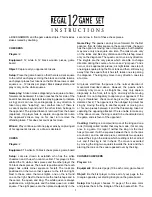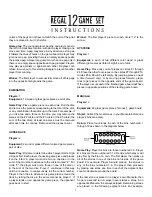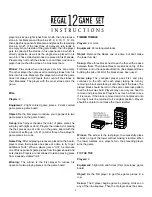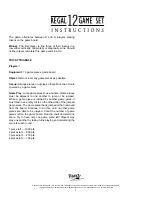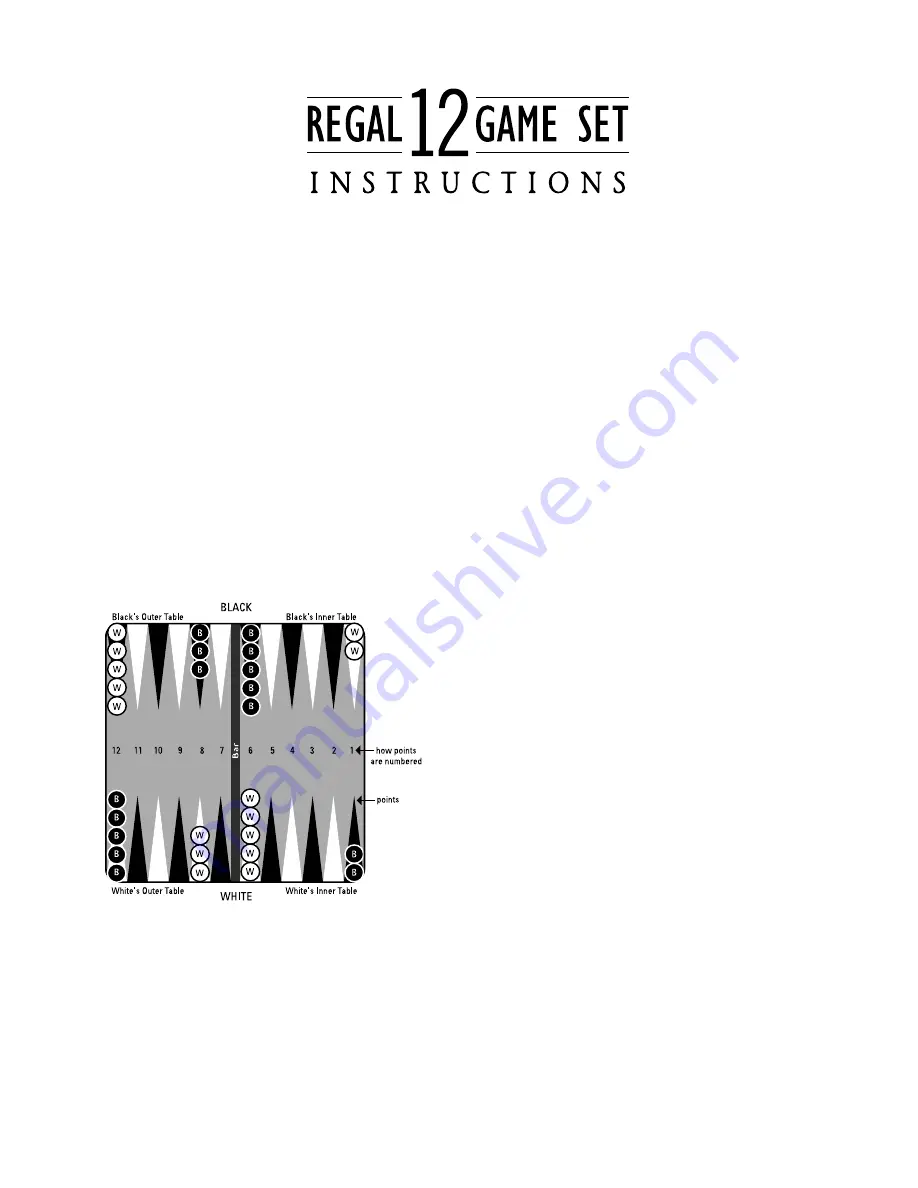
1
BACKGAMMON
Players:
2
Equipment:
15 dark and 15 light color glass pieces (stones)
game board, dice, & doubling die
Object:
Be the first player to move all your stones around
the points on the game board to your home table (your inner
table) and “bear them off” (remove them from the game
board). Usually, several games are played, with the winner
of each game earning points–the first to reach a score of 10
points wins the match.
Set Up:
15 black tokens, 15 white tokens. Players choose
to be the black or white and then set up the game board as
shown below. The game tokens in backgammon are referred
to as “stones.” Each player rolls a die to determine who has
the first move, ties are rerolled. The player with the highest
number will begin the game by using the two high numbers
of the dice that were just cast by himself and his opponent.
Moving Stones:
Count begins on point next to one on
which a stone rests. In general, a player moves the stones
one at a time along the points in a loop that extends from
his opponent’s 1-point to his own 1-point. The opponent’s
stones travel in the opposite direction. Dice advance a stone
forward the rolled number of points and the stone comes to
rest at the base of the point. A player can move two stones,
one for each die, or a single token twice, once for each die.
A player can choose to use only one die, but it must be the
highest count die. If a player rolls doubles, they are doubled
again. (example: a 5-5 becomes a 5-5-5-5 which equals four
separate moves). There is no limit to the number of stones
belonging to the same player that may rest on one point.
A point housing two or more stones of the same player is
BLOCKED against an opponent, and his stones may not
land on that point, although it may be jumped. When a player
cannot move because of blocked points he loses the move.
Blots:
A single stone resting on a point is a BLOT; an
opponent may land on the point and HIT the blot, which
sends it to the bar at the center of the board. A stone on the
Bar must start over on his opponent’s 1-point. This stone
on the Bar must reenter his opponent’s inner table before
making another move. He cannot enter on a blocked point.
Two or more blots may be hit in one play.
Bearing Off:
When either player succeeds in moving all of
his stones around the board to his inner table, he starts to
“bear off” (remove) stones from points corresponding to the
dice thrown. The player can either move a stone within his
inner table or bear it off. For example, a 1-2 that is rolled,
may be used to bear off a stone from the 1-point and the
2-point, or the player may choose to move a stone from the
3-point to the 6-point. When casting a number higher than
any point covered, a stone from the highest point may bear
off, but he cannot bear off a stone if the point indicated is
vacant and there is a stone on a higher counting point. If,
while bearing off, a token is HIT, the player’s stone goes to
the Bar and must reenter in the usual way. This stone must
travel all around the board to his inner table again before
more stones can be moved or taken off.
Doubling:
The doubling cube (the die w/numbers) changes
winners’ scores dramatically; therefore, games are played
to 20 or 50 or more points. At the beginning of the game the
doubling die is neutral and is placed face up on the 64. At
any time during the game a player can turn it so that the 2
is face up and offer it as a “bet” to his opponent, raising the
stakes of the game. If the bet is accepted by the opponent,
the game is now worth 2 points to the winner (instead of the
standard 1 point). If the opponent rejects the bet, he forfeits
the game and his opponent earns 1 point. If the opponent
accepted the bet, he now has the right to double the bet to a
4 later in the game and in turn, the opponent must choose to
accept or forfeit. This scenario may continue indefinitely but
there are usually not more than four or five in any game. The
points increase as follows: 2,4,8,16,32, etc.
Gammon/Backgammon:
The winner of the game is the
first player to remove all his stones from the board. If the
loser has not borne off any of his stones, it is called a
GAMMON and the stakes of the game are doubled. If the
loser still has stones on the winner’s home table, it is called


